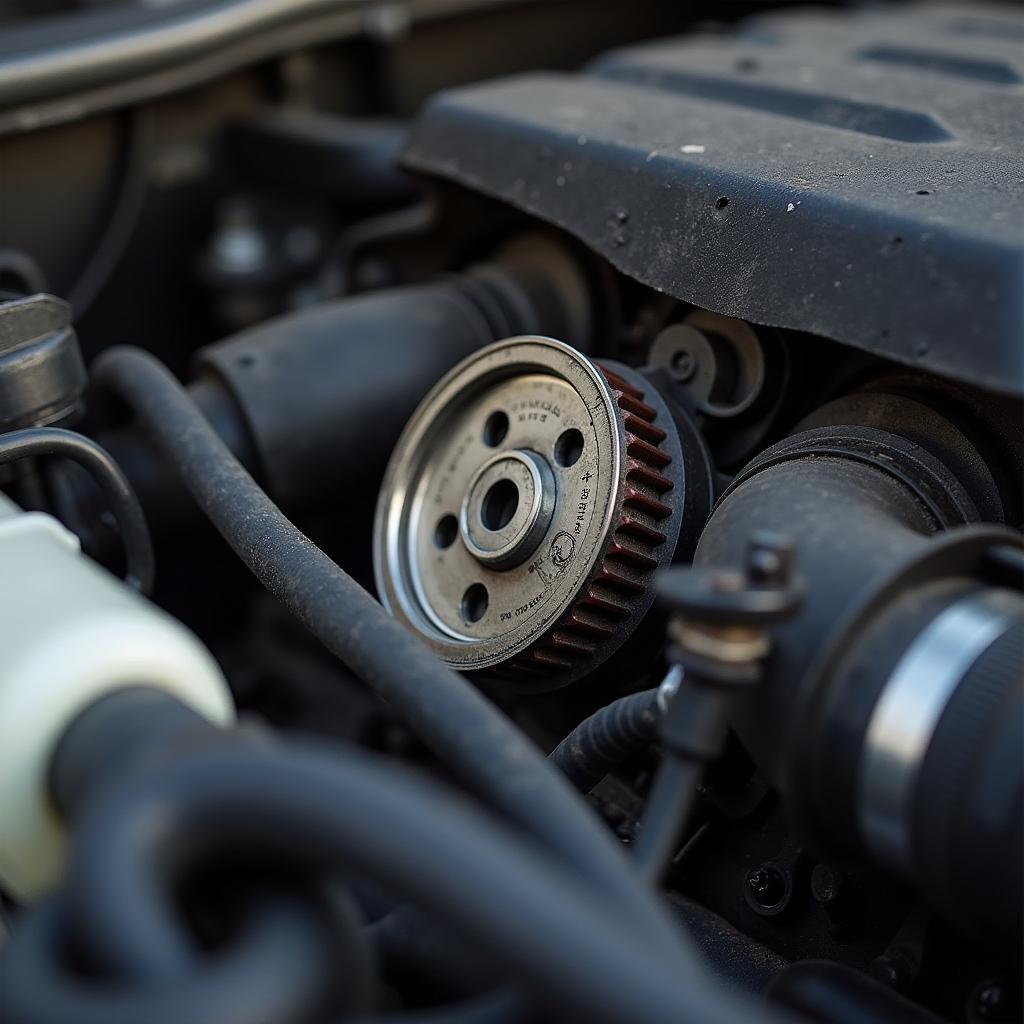A timing belt failure is likely one of every car owner’s nightmares. This small, unassuming part in the engine compartment plays a crucial role in the engine’s function. If it breaks, it can lead to catastrophic engine damage and high repair costs. But what exactly is a timing belt, why is it so important, and what are the signs of a failure? This article answers all important questions about “Timing Belt Failure.”
 Close-up of a timing belt on a car engine
Close-up of a timing belt on a car engine
What is a Timing Belt and Why is it So Important?
The timing belt is an elastic rubber belt with teeth on the inside. It connects the crankshaft to the camshaft and ensures that the valves open and close at the correct moment. This makes the engine’s combustion cycle possible in the first place.
Imagine the timing belt like a chain on a bicycle. If the chain breaks, the bicycle stops immediately. It’s similar with the timing belt in a car. A failure leads to the engine stopping.
What are the Signs of a Timing Belt Failure?
Unfortunately, a timing belt failure rarely announces itself clearly. However, there are some signs that can indicate impending damage:
- Unusual Engine Noises: A loud clicking or rattling sound from the engine compartment can be a sign of a faulty timing belt.
- Loss of Performance: If the timing belt is not functioning correctly, the engine may lose power.
- Starting Difficulties: A faulty timing belt can cause the engine to be difficult or impossible to start.
- Dashboard Warning Light: In some cases, a warning light on the dashboard will illuminate if there is a problem with the timing belt.
 Close-up of a worn timing belt showing signs of damage
Close-up of a worn timing belt showing signs of damage
Should you notice any of these signs, it is important to visit a workshop immediately. Do not ignore the warning signs, because a broken timing belt can lead to catastrophic engine damage.
What are the Consequences of a Timing Belt Failure?
A broken timing belt means that the camshaft is no longer driven and the valves open and close at the wrong time. This can lead to a so-called “piston-to-valve collision,” where the pistons hit the valves and damage them. In most cases, this requires extensive and expensive engine repair or even an engine replacement.
How Often Must the Timing Belt Be Replaced?
The timing belt is a wear part and should therefore be replaced regularly. The replacement intervals vary from vehicle model to vehicle model and can be found in the vehicle’s owner’s manual. Generally, the timing belt should be replaced every 60,000 to 120,000 kilometers or at least every 5 to 10 years.
Timing Belt Replacement: Costs & Repair
The cost for a timing belt replacement varies depending on the vehicle model and workshop. Generally, you can expect costs between 300 and 800 Euros. Often, the water pump and tensioners are also replaced during the timing belt change, as they are also subject to wear.
 Mechanic's hands working to replace a timing belt
Mechanic's hands working to replace a timing belt
Timing Belt or Timing Chain: Which is Better?
In addition to the timing belt, some vehicles are equipped with a timing chain. This has the advantage that it is significantly more durable compared to a timing belt and generally does not need to be replaced. However, a timing chain is more expensive upfront and can be louder in operation than a timing belt.
More information about timing belts can also be found in our articles on the Mercedes Citan Timing Belt Interval, Conti Timing Belts, or the Audi A2 Timing Belt Replacement.
Timing Belt Failure: Questions & Answers
- Can I continue driving with a failed timing belt?No, absolutely not! Continuing to drive with a failed timing belt can lead to catastrophic engine damage.
- How do I know if my timing belt has broken?A broken timing belt is usually noticeable by loud engine noises, loss of performance, or starting difficulties.
- What does it cost to repair engine damage caused by a broken timing belt?Repairing engine damage caused by a broken timing belt can cost several thousand Euros.
Conclusion
The timing belt is an important engine component whose failure can lead to costly engine damage. Pay attention to the signs of a faulty timing belt and adhere to the replacement intervals to avoid expensive repairs. For questions or uncertainties regarding timing belts, our team of car experts is happy to assist you. Contact us via our website or visit our workshop. We are happy to help!

